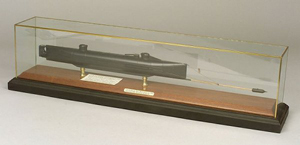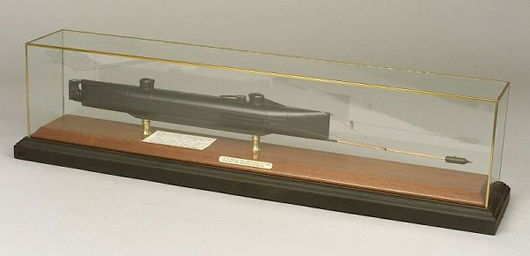
The hand-cranked Hunley, the first submarine in history to sink an enemy warship, went down with the eight-man crew after sinking the Union blockade ship Housatonic.
The sub sank tilted about 45 degrees on its side. It was raised in that position in 2000 and has been oriented that way in slings in a conservation lab ever since.
Last week, scientists began the laborious process of turning the sub upright for the first time since it left on her mission. They slowly raised the Hunley and the steel truss holding it about three feet in its conservation tank.
This week they will put new hardware on the slings and then slowly bring the sub upright to stand on steel keel supports with sophisticated sensors to record the weight each is bearing, said Paul Mardikian, the senior conservator on the Hunley project.
“We want to know how the submarine is being supported and we want the submarine to be supported evenly,” he said.
Scientists have modeled the delicate process of righting the sub both in a computer simulation and with a model of the hull. “If you’re going to do it, you have to do it right,” he said, adding it will probably take two days to bring the Hunley upright.
“It’s been ongoing work for the last three years finding a way to have some sort of control on what will happen to the submarine, the points that will be stressed and how to handle the rotation,” he said.
During the conservation, scientists removed several hull plates to get the human remains and artifacts inside.
“That submarine is much weaker than it was at the time of the recovery,” Mardikian said. “We have removed 10 tons of sediment and while that submarine is lighter, it is still more fragile.”
He said removing the rest of the encrusted sediment on the hull will take about a year to complete once the Hunley is standing on its own on the keel blocks.
Seeing the hull may provide clues as to its sinking.
There are a number of possibilities why the sub sank. It could have been damaged by fire from the Housatonic or perhaps struck by a second Union ship coming to the aid of the blockade ship. It’s also possible the Hunley crew was knocked out by the concussion of the explosion that sank the Housatonic.
The clues indicate the crew died of anoxia, a lack of oxygen which can overtake a person very quickly, and didn’t drown. The remains of the crew were found at the crank stations and they seemed to be no rush for an escape hatch.
One of the crane operators who helped raise the Hunley last week was there a decade ago to lower it initially into its conservation tank.
Cecil Douglas of Parker Rigging said it was easier to raise the Hunley a few feet than to move it into position in its tank in 2000. And he says he’s not done with the Hunley.
“I plan to be here to take it out” when the conservation is complete and the Hunley is moved to a museum, he said.
But first comes the rotation.
“Having that submarine on keel blocks will be incredible for archeologists and incredible for the public because they have never seen the Hunley upright,” Mardikian said.
Copyright 2011 Associated Press. All rights reserved. This material may not be published, broadcast, rewritten, or redistributed.
AP-WF-06-19-11 1558GMT
ADDITIONAL IMAGE OF NOTE


